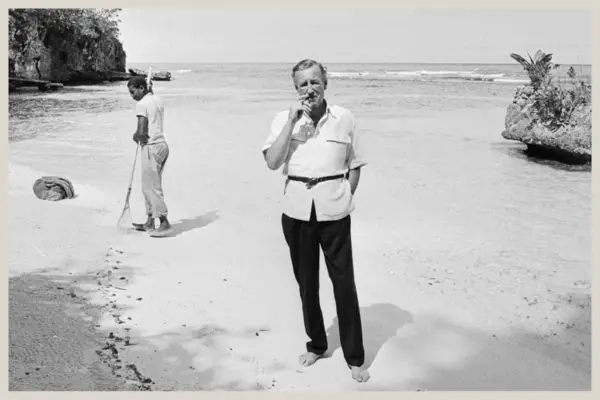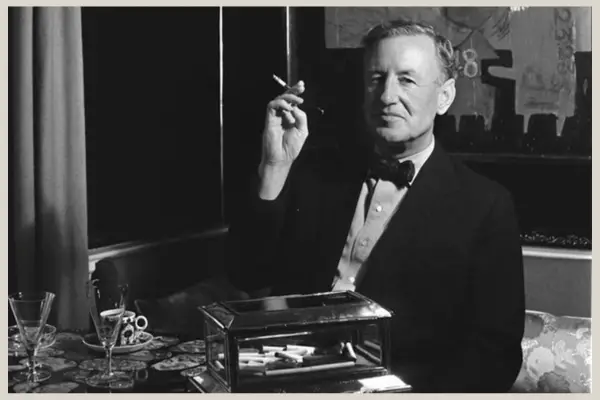Ian Fleming: Shaken, Stirred, and Forever Immortalised
In the annals of literary and cinematic legacy, few can boast a shadow as long, thrilling, and dapper as that cast by Ian Fleming. The erstwhile naval intelligence officer, with a knack for blurring his wartime escapades with fictitious flair, birthed none other than the martini-sipping, tuxedo-clad super spy – James Bond.
Fleming, with a stroke of his pen ushered in an era. An era where espionage leapt out of shadowy alleyways and into the glitzy realm of casinos, fast cars, and even faster romances. In weaving Bond’s tales, Fleming didn’t just contribute to the soy genre, he revolutionised it, setting a gold standard that few could match but many would emulate.
Today, decades after Bond’s debut in the smoke-filled casinos of his first novel, Casino Royale, Fleming’s influence remains indelible, shimmering across the broad canvas of popular culture like the barrel of 007’s Walther PPK, always promising the allure of danger, drama, and undeniable style.
From Mayfair to Mainstream: The Formative Years of Ian Fleming
1908 marked not just the end of an era but the dawn of a legend. Born into the opulence of Mayfair, Fleming’s beginnings were as illustrious as the settings of his most famous character’s rendezvous.
The world of Fleming was one of privilege and pedigree, with a family deeply rooted in the tapestry of British high society. His father, Valentine Fleming, served with distinction in the Westminster parliament, while his lineage could trace its connections to the eminent banking families of Europe.
Yet, beneath the veneer of privilege lay the restless spirit of an adventurer. Ian Fleming’s educational journey, one that spanned the corridors of Eton to the stately halls of Sandhurst, was less about academic rigour and more a canvas for his budding passions.
A stint at Kitzbühel in Austria under the tutelage of former spy Ernan Forbes Dennis perhaps sowed the earliest seeds of Bond in the young Ian’s imagination. Whether studying languages in Munich and Geneva or penning for The Times, Fleming’s experiences always seemed to transcend the ordinary.
The pages of his textbooks might have been filled with history and languages, but it was the blank spaces in between where Fleming’s imagination ran wild, crafting tales of intrigue, shadow games, and a world waiting to be explored.
These early brushstrokes would, in time, come together to paint the grand tapestry of espionage and allure that James Bond came to epitomise.

From Desk to Deeds: The Shadows of War and the Birth of 007
The thrum of wartime London was a far cry from the elegant salons of Fleming’s youth. As the world teetered on the edge of chaos, Fleming found himself at the heart of Britain’s desperate bid to outwit its enemies.
His role within the hallowed halls of the Naval Intelligence Division, while far from the front lines, was no less crucial. Charting the course of intelligence operations, Fleming’s pen danced as deftly across classified memos as it would later across the pages of Bond novels.
His tenure at Room 39 of the Admiralty, the nexus of wartime subterfuge, saw Fleming masterminding operations that often rivalled the best of Bond’s escapades. Whether orchestrating the ill-fated Operation Goldeneye or crafting the blueprint for what would later become the CIA, Fleming was as enigmatic and daring as his fictional counterpart.
His creation of the 30 Assault Unit, a commando troop tasked with snatching enemy intelligence, offered an intimate glimpse into the raw, unpolished world of espionage. These men, who risked life and limb behind enemy lines, were perhaps the earliest avatars of the suave yet deadly 007.
Amidst the din of war, the contours of a certain secret agent began to emerge. The characters Fleming met, the operations he oversaw, and the world of shadows he inhabited became the crucible for James Bond’s genesis.
Those adrenaline-fueled days, where the stakes were as real as the cold steel of a Walther PPK, etched into Fleming a repository of tales and intrigue. From these memories, born in the throes of war and cloaked in secrecy, James Bond would step forth, as dashing and indomitable as the man who dreamt him up.
Birth of an Icon: The Cocktail of Reality and Fiction That Conceived 007
Every hero’s journey starts somewhere, and for James Bond, that place was Jamaica – far removed from the grey corridors of MI6 or the glamorous casinos of Monte Carlo. Surrounded by the lapping waves and humming cicadas of Goldeneye, his beloved Caribbean retreat, Fleming conjured a world where the lines between his wartime experiences and pure fantasy blurred.
The very name ‘James Bond’ was inspired by the rather unassuming author of an ornithology guide that rested on Fleming’s bookshelf. Seeking the plainest, dullest, and most straightforward moniker he could find, Fleming decided on ‘James Bond’.

There was no pretense about it, a clear, sharp name for a clear, sharp character. And James Bond it would be.
When Casino Royale hit the shelves in 1953, readers were introduced to this enigmatic figure: an agent with a penchant for high stakes, both at the gambling table and in the line of duty.
The world of spies had seen its share of characters, but none quite like Bond. He wasn’t just a hero, he was a lifestyle. The seductive mix of danger, luxury, and moral ambiguity presented in Fleming’s prose was irresistible. Instead of operating in the world of espionage, Bond danced through it with a martini in hand.
Throughout the 1950s, as the shadows of the Cold War loomed large, Bond’s adventures became synonymous with escape for readers worldwide. His encounters with SMERSH, the very embodiment of the Eastern threat, resonated with the anxieties of the age, albeit with a dose of exoticism and thrill.
The very fabric of Bond’s universe – the Cold War setting, the larger-than-life villains, and the romantic entanglements – mirrored the zeitgeist, but with an added dash of allure.
The 1960s heralded not just a new decade but a veritable Bond mania. With each subsequent novel, Fleming refined and expanded the Bond universe, while readers, hungry for more, devoured the tales with increasing fervour.
From the sultry streets of Havana in his second novel, Live and Let Die to the treacherous peaks of the Swiss Alps in On Her Majesty’s Secret Service, Bond’s escapades spanned the globe. And as he travelled, so did millions, vicariously living out fantasies of danger, passion, and luxury.
By the time the world bid farewell to the 1960s, James Bond was no longer just a character in a series of novels. He was an icon, a symbol of a bygone era and a beacon for the future. A testament not just to Ian Fleming’s imaginative genius, but to the enduring allure of the world he created – where danger met desire, and the stakes were always, thrillingly, sky-high.
From Espionage Epics to Enchanted Automobiles: Fleming’s Indelible Literary Mark
Ian Fleming’s dexterous hand didn’t simply give birth to the world’s most iconic spy, it penned a range of works that captured the hearts and minds of readers far and wide. While the magnetic pull of the Bond series is undeniable, Fleming’s literary prowess danced across genres and tones, each piece a testament to his versatility.
The Bond novels themselves are rich tapestries of character, intrigue, and exoticism. From the glamorous casinos of Casino Royale to the Eastern delight Bond experiences in You Only Live Twice, each novel is a passport to a world of danger and desire.
By the time The Man with the Golden Gun emerged, the last published in his lifetime, the Bond series was not just a collection of books but a cultural phenomenon, a touchstone against which all other thrillers were measured.

But to label Fleming merely as the creator of Bond does him a disservice. In The Diamond Smugglers, he dipped his toes into the realm of factual reporting, taking readers on a suspense-filled journey into the clandestine world of diamond smuggling.
Thrilling Cities finds Fleming swapping the gun for the pen in a different sense, chronicling his journeys around the world. It’s a travelogue with a twist, as the inimitable Ian Fleming touch lends vibrancy to each metropolis he traverses.
Tokyo’s neon allure, the old-world charm of Vienna, the dizzying rush of New York – all are captured with the same verve and vigour that characterises his fiction.
And then, of course, there’s Chitty-Chitty-Bang-Bang, a delightful deviation from his usual milieu. In this whimsical tale for children, Fleming crafts a story of a magical car and the adventures it whisks its passengers away on. It’s a world away from the martinis and mayhem of Bond, but no less enchanting, and another of his books to make it onto the silver screen.
A Bond Beyond Time: The Living Legacy of Ian Fleming
The man may have left the world behind, but the world Ian Fleming crafted is very much alive – thriving, influencing, and evolving with a dynamism that speaks volumes of its timeless appeal.
The sting in the tale, posthumously, was The Man with the Golden Gun, a novel that saw Bond in a light less shone, if not slightly dimmed. It was a manuscript Fleming had not fully honed, yet even in its raw form, it carried the unmistakable pulse of his narrative heart.
Then came Octopussy and The Living Daylights, a collection seeped in the nuanced elegance and simmering tension that had become synonymous with Fleming’s penmanship.
Yet, the inkwell of Bond was far from dry. The world’s thirst for 007’s adventures spurred a literary relay race, with several authors such as Kingsley Amis and Sebastian Faulks picking up the baton from where Fleming had left, injecting their own spirit while ensuring Bond’s essence remained undiluted.
Parallel to this was Bond’s celluloid journey. Initiated by Eon Productions with Dr. No in 1962, the series metamorphosed into a cinematic colossus.
Through the decades, through multiple avatars of Bond – from the suave Sean Connery to the brooding Daniel Craig – these films not only celebrated Fleming’s creation but also ensured it was introduced to generations anew, with adaptations that matched the changing sensibilities of global audiences.
Ian Fleming’s touch, however, was not restricted to the confines of Bond. Modern cinema and literature are replete with nods to his genius. The zany antics of Austin Powers, the gritty realism of Jason Bourne, all carry the Fleming hallmark, albeit in varied shades.
Yet, perhaps the most heartwarming tribute to Fleming is not on paper or on screen. It’s etched on the Jamaican soils he loved so deeply. The Ian Fleming International Airport, opened in 2011, stands as a testament to his soaring legacy.
In his lifetime, Ian Fleming scripted adventures. In his afterlife, he became one. The tale of a writer who not only documented escapades but also became an eternal escapade in the annals of cultural history.

A Legacy License to Thrill: Concluding Ian Fleming’s Tale
There are writers who pen stories, and then there are those who sculpt epochs. Ian Fleming, in his relatively short span of creative outpouring, managed to craft not just a character, but an enduring emblem of intrigue, charm, and resilience.
His life was as textured and multifaceted as his novels. From the hallowed halls of Eton to the clandestine corners of the Naval Intelligence Division, from the sun-kissed beaches of Jamaica to the bustling streets of cities that thrilled him – Ian Fleming traversed a journey that reads as fascinatingly as any Bond adventure.
The commercial successes, the cinematic adaptations, and the accolades are, of course, tangible tokens of his genius. But the real testament lies in the timeless appeal of his creations. In a world of ephemeral attention spans and fleeting trends, Bond’s longevity and the continued resonance of Fleming’s other works showcase a depth that goes beyond mere surface glamour.
In retrospect, it’s evident that Ian Fleming didn’t just write. He enchanted, he provoked, he engaged. He invited us into a world of his making, and decades later, we’re still happily ensnared, sipping on a martini – shaken, not stirred – and raising a toast to a literary legend whose legacy is, quite fittingly, forever.
Ian Fleming’s Works
Ian Fleming, best known for creating the iconic James Bond character, penned a prolific number of works during his lifetime. Here is a summarized list of his contributions:
James Bond Novels:
- Casino Royale (1953): The debut of James Bond, where he battles the sinister Le Chiffre at the gambling tables.
- Live and Let Die (1954): Bond confronts Mr. Big and voodoo mysteries.
- Moonraker (1955): Bond investigates the millionaire Sir Hugo Drax.
- Diamonds Are Forever (1956): Bond enters the world of diamond smuggling.
- From Russia, with Love (1957): A complex plot to assassinate Bond using a beautiful Russian agent.
- Dr. No (1958): Bond confronts the sinister Dr. Julius No in Jamaica.
- Goldfinger (1959): Bond pits himself against the gold magnate Auric Goldfinger.
- Thunderball (1961): Bond tracks down two atomic bombs stolen by SPECTRE – the first novel to introduce the infamous organization.
- The Spy Who Loved Me (1962): Told from the perspective of a woman who encounters Bond.
- On Her Majesty’s Secret Service (1963): Bond faces Blofeld in a snowy retreat.
- You Only Live Twice (1964): Bond’s adventures in Japan and another face-off with Blofeld.
- The Man with the Golden Gun (1965): Bond’s showdown with the assassin Scaramanga.
James Bond Short Story Collections:
- For Your Eyes Only (1960): A collection of short stories including From a View to a Kill and Quantum of Solace.
- Octopussy and The Living Daylights (1966): A compilation of short stories published posthumously.
Other Works:
- The Diamond Smugglers (1957): A non-fiction work detailing the diamond trade.
- Thrilling Cities (1963): Fleming’s observations from his world tours, recounting experiences from cities around the world.
- Chitty-Chitty-Bang-Bang (1964): Fleming’s only children’s book, telling the story of a magical car.





